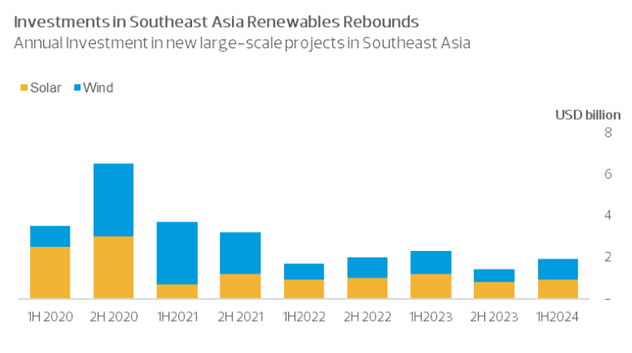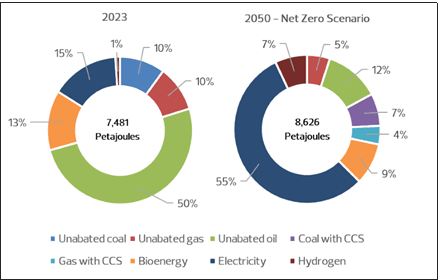Global Trends in Renewable Energy
In 2022, approximately 295 GW of renewable energy capacity was added, representing 83% of new global power generation. This growth primarily driven by solar and wind investments, supports climate goals like the Paris Agreement and Net Zero Emissions (NZE) by 2050. The UN emphasizes the need to cut global emissions by 45% by 2030. China led the transition, accounting for nearly half of global renewable additions with solar making up almost two-thirds of the new capacity.
Despite progress, current investments are still inadequate. Southeast Asia contributes less than 2% of global clean energy investment, averaging USD 72 billion annually in recent years. To meet NZE targets, this must nearly double USD 130 billion per year by 2030.
ASEAN Renewable Energy Commitments
ASEAN nations have set ambitious goals to support NZE by 2050. Under the ASEAN Plan of Action for Energy Cooperation (APAEC), ASEAN aim for 23% renewable energy in the total primary energy supply and 35% of installed power capacity from renewables by 2025, equivalent to approximately 175 GW.
As of 2022, renewables made up 33.6% of ASEAN’s installed capacity, indicating progress toward targets. However, renewables only account for 15% of total primary energy supply. While an additional 91 GW is expected by 2030 reaching 96 GW. This remains insufficient for full decarbonization. Solar and wind investments have accelerated, with Southeast Asia reaching USD 1.8 billion in financing by mid-2024, up 34% from the previous six months.

Indonesia’s Renewable Energy Landscape
Indonesia plays a key role in the regional transition with over 3,000 GW of renewable potential. However, deployment remains modest. In 2023, fossil fuels made up 87% of the energy supply, while renewables contributed only 13.1% to the mix and 13.5 GW in capacity and can be described below.

The projected fourfold increase in electricity demand by 2050 further highlights the urgency of transitioning. Most of Indonesia’s renewable generation still comes from hydro and geothermal sources.
Gap Analysis: Today vs. Future Targets
Indonesia continues to make steady progress toward its 2025 renewable energy target, currently at around 13%, and contributing to ASEAN’s 175 GW goal with potential for further growth.

Demand is projected to surge by industrialization and urbanization. To meet NZE by 2060, Indonesia needs an estimated USD 3.8 trillion in energy investments by 2050 (USD 37 billion annually) yet current annual investments remain below USD 10 billion.

State utility PLN’s most recent Electricity Supply Plan (RUPTL) outlines a path to add 32 GW of renewables by 2030. It also commits to increasing the share of renewables in new capacity additions to over 75%.
To support the acceleration of renewable energy projects, the Indonesian government enacted Ministerial Regulation ESDM No. 5/2025, which governs Power Purchase Agreements (PPAs) between PLN and Independent Power Producers (IPPs). This regulation provides greater contractual clarity and ensures 30-year procurement terms, thereby enhancing investor confidence, ensuring long-term bankability, and aligning procurement practices with global standards.
National Strategies and EV Implementation
President Prabowo Subianto has committed to reducing coal reliance and adding 75 GW of renewable capacity over the next 15 years and also emphasize sustainability through electric vehicle (EV) adoption.

EV adoption in Indonesia has grown rapidly between 2021 and 2023 due to Presidential Regulation No. 55/2019, which mandates local manufacturing and tech transfer. The Ministry of Finance supports this shift through motorcycle subsidies and lower taxes on electric cars. As of April 2024, Indonesia recorded over 133,000 electric vehicles, most of which are two-wheelers.
Conclusion: Seizing the Opportunity
Despite immense renewable energy potential, Indonesia remains far from achieving its climate targets. Its current installed capacity of 13.5 GW is significantly below PLN’s 2030 target of 32 GW. Achieving Net Zero by 2060 demands accelerated investment, regulatory clarity, and technological advancement.
This gap presents a strategic opportunity for investors. Indonesia’s energy transition opens private collaboration and sustainability partnerships to shape its future.
As the government moves to integrate renewable energy deeply into its development agenda, now is the time for stakeholders to engage because it is no longer just an environmental imperative, it is a market transformation.
By Syahadam Manaf, Consulting Practice

